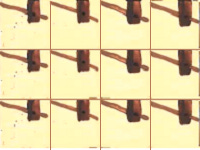John Curry has re-issued Don Featherstone’s Naval War Games from 1965 as part of the History of Wargaming project. This book is essential for anyone interested in Naval Wargames or who wants to add a naval dimension to their land-based wargame campaign.
The first two sections of the book, some 70 pages, are devoted to the history of naval wargaming rules. This is an absolute treasure trove of information about our hobby, most of which I did not know. For example, the oldest known naval wargame rules date back to the 1890s!
The second section contains several sets of instructions and diagrams for making your own ships, from the Roman galley of 200 BC & 40-gun frigate of 1800 to the metal battleships of the 20th century.
For my own ships, I cheated a little, using some drawings I found on the internet, from a top-down perspective, and glued them to foam core sheeting. I then simply glued a toothpick in for the mast and cut a sail out of thick card.
The blue tokens you see in the picture represent “platoons” of ten marines, armed for ranged and ship-to-ship combat.
I played two (very small) battles using these ships and some make-shift counters. The game moves quickly and has a good feel for the period. The rules are not complex at all, and could easily manage a larger fleet of ship and multiple players.
Rules Observations
Movement is abstracted, in that ships under sail move 15” with the wind and 9” against it. No need to actually manage tacking back-and-forth. ships under oar move 12”, regardless of the wind. An interesting aspect of ship-to-ship combat is that the mast needs to be lowered for ramming, the preferred method of attack.
The ship is not able to move at all during the turn that the mast is being raised or lowered, which creates an interesting tactical choice for the player. When do you stop to lower the mast?
I love the idea of a catapult on the stern of the larger galley. Catapults are not the most reliable, needed a 3+ just to get loaded each turn, then hitting on a 4+ out to 12” and 5+ out to 24”. Once you do manage to load, fire, and hit, there is only a 3-in-6 chance of holing the ship. That said, when a ship is holed, it is very likely to sink in 2 turns. Savage.
Archery and hand-to-hand combat are handled in a fashion reminiscent of archery in Chainmail, where the hail of arrows causes casualties without rolling “to hit”. In this, the wounded do get a Save, based on any armor they might be wearing.
I will be doing another playtest video for a battle that includes ship-to-ship grappling and boarding actions.
The rules are a little vague on a couple of things, including minimum movements, turn-to-turn speed changes, and how movement works while the crew is doing other things (like trying to plug a hole!).
When these came up during the video, I simply made an executive decision, based on what seemed the right thing to do.
Check out the video here:
Statistics and Tracking Damage
It quickly became apparent that you need some particular counters for the ships, in case they are holed by catapult fire, or whether the mast is up or down. I have made an assortment of half-inch counters to use for future games, and painted some Dragon-ship-style top-downs to use in other scenarios.
In particular there is a scenario involving 6mm Lizardmen vs Beastmen where I’d like to add a naval component. You can get the counters free at the itchio page - Download the top-downs and counters. (If you think of some that could be added, please let me know and I’ll update the sheets.) the counters look like this:




There are not a lot of things to keep track of on the ships themselves, when it comes to damage. The movement system and the damage systems are very simple and basic. There are enough however, that tokens won’t really work (plus, they clutter up the table), so I made a small Ship Record sheet, the size of a 3” x 5” index card. These are available on the same PDF as the counters.
Conclusions
There is a lot of game here, in just a few pages of rules. It is a bit incomplete, like many games of the era, but the gaps are easily crossed by an experienced gamer. I have made some notes about what I might change, especially with the Basic Massed Combat System in mind.
I am not going to actually write any rules, or rule changes, until I have studied the other systems in this book, and the rest of the research queue.
Don’t Give Up the Ship by Arneson, Gygax & Carr is next up on the table, followed by Gridded Naval Wargames by Bob Cordery. The fourth set of rules, Thalassa, was included with a recent issue of Wargames Illustrated. I added it to the list, as it looks interesting. (This is where I got the idea of putting a token on the ship to represent the marines.) Sadly the ships are outrageously expensive, or I guess you can buy STL files and print your own. YMMV
Resources
PDF Download of counters and top-down ship miniatures.








Great stuff, as always.